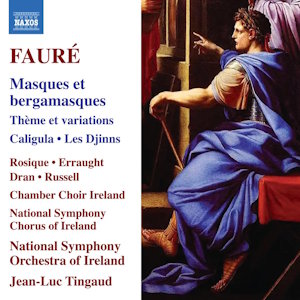
Gabriel Fauré (1845-1924)
Les Djinns, op. 12 (version for choir & orchestra)
Caligula, op. 52 (concert version)
Thème et variations, op. 73 (orch. Désiré-Émile Inghelbrecht)
Masques et bergamasques, op. 112 (stage version)
Ruth Rosique (soprano), Tara Erraught (mezzo-soprano), Julien Dran (tenor), Benjamin Russell (baritone)
Chamber Choir Ireland
RTÉ National Symphony Orchestra & Chorus/Jean-Luc Tingaud
rec. 2023/24, National Concert Hall, Dublin, Ireland
Naxos 8.574647 [62]
Many music lovers might know Gabriel Fauré for two or three works. Most pertinent is the serene and ethereal Requiem. Others will gravitate towards the ever-popular Pavane or the charming and playful Dolly Suite. Dig deeper, and you will discover piano pieces such as Nocturnes or Barcaroles. This disc contains a selection of Fauré’s secular choral and theatrical music that remains “relatively unknown”. And there is the premiere recording of the Thème et variations in its orchestral arrangement.
Enthusiasts of Fauré’s Requiem will find his c.1875 setting of Victor Hugo’s Les Djinns slightly disconcerting. The liner notes say that he is in “unfamiliar territory” with this powerful setting that captures the eerie and otherworldly presence of supernatural beings. It is not a theme that would normally have appealed to him. He first scored it for piano and chorus, and later orchestrated.
New to me is the incidental music to Alexandre Dumas’s play Caligula first staged in 1837. Fauré wrote the score for the play’s revival at the Théâtre de l’Odéon in Paris in 1888. It includes four choruses for female voice and a few orchestral interludes, fanfares and marches. It is fair to say that this sixteen-minute concert suite does not focus on the power-hungry, controversial, tyrannical life of the emperor but on the “feelings of the women of [his] court”. Charles Koechlin has described it as “beautiful, and on a par with the beauty of antiquity.” I am not sure how effective this would be in the concert hall, but it is good to have it “on record”.
Fauré completed Thème et variations for piano solo in 1895. The French composer and pianist Léon Delafosse premiered it in London on 10 December 1896. It is often regarded as Fauré’s most significant work for the instrument; it is certainly the longest. Lyrical elegance is counterpointed with subtle harmonies and emotional depth. The conductor Désiré-Émile Inghelbrecht orchestrated it in 1955. In a skilful arrangement, he has elaborated Fauré’s intention. Various solo instruments explore the contrapuntal strands of the variations, with never a moment of monotony. The work is marked by contrasts of seriousness and passion, and of resignation and triumph. Stylistically, it nods towards Brahms and Schumann.
Masques et bergamasques, a theatrical divertissement, combines newly devised music and earlier pieces from across Fauré’s career. It was commissioned by Prince Albert I of Monaco, with a libretto by the French dramatist René Fauchois, and premiered in Monte Carlo in 1919. Rooted in the French fête galante (courtship party) tradition, inspired by poets like Verlaine and painters such as Watteau, it evokes idyllic, nostalgic scenes of aristocratic leisure. There is a good-humoured twist: characters like Harlequin and Columbine observe, rather than entertain, their usual audience.
The work includes vocal and instrumental movements.It incorporates classical dance forms like the Menuet and Gavotte, alongside orchestrations of earlier pieces such as the song Clair de lune and the Madrigal. The freshly written Pastorale complements these movements, and the justly popular Pavane from 1887 concludes the suite with its “bittersweet mood”. After its debut, it resonated with audiences, but post-World War I its nostalgic charm reflected an “Arcadian” bygone era, and Masques et bergamasques slipped into desuetude. Its suitably rewarding performance on this disc reveals Fauré’s capacity for blending tradition with his distinctive elegance.
Caroline Potter’s comprehensive booklet notes, in English only, provide a helpful introduction to this rare repertoire. The texts are included only in French. The cover features a detail from the sombre painting of Caligula Depositing the Ashes of his Mother and Brother in the Tomb of his Ancestors (1647) by Eustache Le Sueur (1617–1655).
This disc may not appeal to the general listener. But to anyone who wishes to dig deeper into Fauré’s considerable catalogue, it is an essential contribution, well planned and superbly performed.
John France
Buying this recording via a link below generates revenue for MWI, which helps the site remain free




















